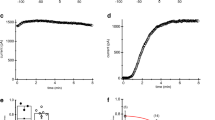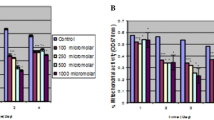Abstract
Effects of organotin compounds were studied on voltage-gated K+ current in whole-cell voltage clamped lymphocytes and in NlE-115 neuroblastoma cells. In human peripheral blood lymphocytes the immunotoxic compounds dibutyltinchloride (DBT, 2.5 μM) and triphenyltinchloride (TPhT, 2.5 μM) decrease the peak amplitude of the K+ current and prolong time to peak. Tributyltinchloride (TBT, 2.5 μM) decreases the K+ current to a greater extent than DBT and TPhT, without affecting the time to peak. The neurotoxic organotin compound trimethyltinchloride (TMT, 2.5 μM) does not affect the voltage-gated K+ current in lymphocytes. Similar effects of DBT were observed in freshly isolated and PHA-activated human lymphocytes and with rat thymocytes. On the other hand, in mouse NIE-115 neuroblastoma cells, none of the organotin compounds altered the voltage-dependent K+ current.
In human lymphocytes DBT affects both the peak amplitude and the time to peak of the K+ current in a concentration-dependent manner. At the maximum concentration of 10 μM tested, the peak amplitude of the K+ current was reduced to 22 ± 4% of the control current. The IC50 and slope factor for block of the peak outward current by DBT amounts to 6.7 ± 0.4 μM, and 2.7 ± 0.4, respectively. The delay in K+ current activation does not saturate. At 10 μM DMT increases the time to peak to 332 ± 12% of the control value. The present results suggest that the effects by DBT originate from two separate interactions with the voltage-gated K+ channel at the extracellular site of the membrane: a direct effect on the closed K+ channel causing a delay in current activation and a membrane-related effect causing inhibition of the K+ current. The differential effects of the organotin compounds may relate to their differential toxicological action.
Similar content being viewed by others
References
Allen CN, Fonnum F (1984) Trimethylin inhibits the activity of hippocampal neurons recorded in vitro. Neurotoxicology 5:23–30
Amigorena S, Choquet D, Teillaud, Korn H, Fridman WH (1990) Ion channel blockers inhibit B cell activation at a precise stage of the G1 phase of the cell cycle; Possible involvement of K+ channels. J Immunol 144:2038–2045
Armstrong DL, Read HL, Cork AE, Montemayor F, Wayner MJ (1987) Effects of trimethyltin on evoked potentials in mouse hippocampal slices. Neurotoxicol Teratol 9:359–362
Attali B, Romey G, Honoré E, Schmid-Alliana A, Mattéi MG, Lesage F, Ricard P, Barhanin J, Lazdunski M (1992) Cloning, functional expression, and regulation of two K+ channels in human lymphocytes. J Biol Chem 267:8650–8657
Bierkamper GG, Buxton ILO (1990) Neurotoxicology of organotin compounds. In: Foulkes EC (ed) Biological effects of heavy metals volume I. CRC Press, Boca Raton, pp 97–170
Boyer IJ (1989) Toxicity of dibutyltin, tributyltin and other organotin compounds to humans and to experimental animals. Toxicology 55:253–298
Cahalan MD, Chandy KG, DeCoursey TE, Gupta S (1985) A voltage-gated potassium channel in human T lymphocytes. J Physiol (Lond) 358:197–237
Cai YC, Osborne PB, North RA, Dooley DC, Douglass J (1992) Characterization and functional expression of genomic DNA encoding the human lymphocyte type n potassium channel. DNA Cell Biol 11:163–172
Chandy KG, DeCoursey TE, Cahalan MD, McLaughlin C, Gupta S (1984) Voltage-gated potassium channels are required for human T lymphocyte activation. J Exp Med 160:369–385
Chikahisa L, Oyama Y (1992) Tri-n-butyltin increases intracellular Ca2+ in mouse thymocytes: A flow-cytometric study using fluorescent dyes for membrane potential and intracellular Ca2+. Pharmacol Toxicol 71:190–195
Chow SC, Kass GEN, McCabe MJ, Orrenius S (1992) Tributyltin increases free Ca2+ concentration in thymocytes by mobilizing intracellular Ca2+, activating a Ca2+ entry pathway, and inhibiting Ca2+ efflux. Arch Biochem Biophys 298:143–149
DeCoursey TE, Chandy KG, Gupta S, Cahalan MD (1984) Voltage-gated K+ channels in human T lymphocytes: a role in mitogenesis? Nature 307:465–468
Grinstein S, Dixon SJ (1989) Ion transport, membrane potential, and cytoplasmic pH in lymphocytes: changes during activation. Physiol Rev 69:417–481
Hamill OP, Marty A, Neher E, Sakmann B, Sigworth FJ (1981) Improved patch-clamp techniques for high-resolution current recording from cells and cell-free membrane patches. Pflügers Arch 391:85–100
Krigman MR, Silverman AP (1984) General toxicology of tin and its organic compounds. Neurotoxicology 5:129–140
Leinders T, Vijverberg HPM (1992) Ca2+ dependence of small Ca2+-activated K+ channels in cultured NlE-115 mouse neuroblastoma cells. Pflügers Arch 422:223–232
Lewis R, Calahan MD (1989) Mitogen-induced oscillations of cytosolic Ca2+ and transmembrane Ca2+ current in human leukemic T cells. Cell Regulation 1:99–112
Moolenaar WH, Spector I (1978) Ionic currents in cultured mouse neuroblastoma cells under voltage-clamp conditions. J Physiol (Lond) 278:265–286
Naalsund LU, Allen CN, Fonnum F (1985) Changes in neurobiological parameters in the hippocampus after exposure to trimethyltin. Neurotoxicology 6:145–158
Oyama Y, Akaike N (1990) Triphenyltin: a potent excitatory neurotoxicant. Its reciprocal effects on voltage-dependent Na and K currents of mammalian brain neuron. Neurosci Lett 119:261–264
Oyama Y, Chikahisa L, Tomiyoshi F, Hayashi H (1991) Cytotoxic action of triphenyltin on mouse thymocytes: a flow-cytometric study using fluorescent dyes for membrane potential and intracellular Ca2+. Jpn J Pharmacol 57:419–424
Pieters RHH, Bol-Schoenmakers M, Lam B, Perminks AIL Seinen W (1992) Organotin-induced thymus atrophy concerns the 0X44 immature thymocytes. Thymus 14:79–88
Pieters RHH, Bol M, Penninks AH (1994) Immunotoxic organotins as possible model compounds in studying apoptosis and thymocyte differentiation. Toxicology 91:189–202
Quandt FN (1988) Three kinetically distinct potassium channels in mouse neuroblastoma cells. J Physiol (Lond) 395:401–418
Rudy B (1988) Diversity and ubiquity of K channels. Neuroscience 25:729–749
Sands SB, Lewis RS, Cahalan MD (1989) Charybdotoxin blocks voltage-gated K+ channels in human and marine T lymphocytes. J Gen Physiol 93:1061–1074
Sharma B (1988) Inhibition of the generation of cytotoxic lymphocytes by potassium ion channel blockers. Immunology 65:101–105
Snoeij NJ, Penninks AH, Seinen W (1987) Biological activity of organotin compounds: an overview. Environ Res 44:335–346
Snoeij NJ, Penninks AH, Seinen W (1988) Dibutyltin and tributyltin compounds induced thymus atrophy in rats due to a selective action on thymic lymphoblasts. Int J Immunopharmacol 10:891–899
Verheugen JAH, Oortgiesen M, Vijverberg HPM (1994) Veratridine blocks voltage-dependent potassium current in human T lymphocytes and in mouse neuroblastoma cells. J Membr Biol 137:205–214
Vighi M, Calamari D (1985) QSARs for organotin compounds on Daphnia magna. Chemosphere 14:1925–1932
Author information
Authors and Affiliations
Rights and permissions
About this article
Cite this article
Oortgiesen, M., Visser, E., Vijverberg, H.P. et al. Differential effects of organotin compounds on voltage-gated potassium currents in lymphocytes and neuroblastoma cells. Naunyn-Schmiedeberg's Arch Pharmacol 353, 136–143 (1996). https://doi.org/10.1007/BF00168750
Received:
Accepted:
Issue Date:
DOI: https://doi.org/10.1007/BF00168750




